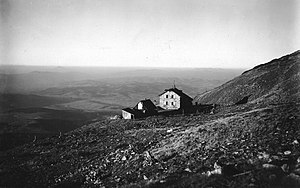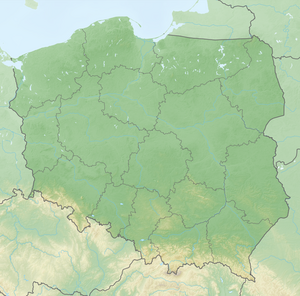Schlesinger House on Babia Góra
| Schlesinger House on Babia Góra (Polish: Schronisko turystyczne na Babiej Górze) ( dismissed ) |
||
|---|---|---|
|
Hut in the 1930s |
||
| location | Southeast slope of Babia Góra ; Poland | |
| Mountain range | Saybuscher Beskids | |
| Geographical location: | 49 ° 34 '14.4 " N , 19 ° 31' 57.5" E | |
| Altitude | 1616 m npm | |
|
|
||
| Built | 1905 | |
| Construction type | Hut; stone | |
The Schlesinger-house on the Babiogórski even hut on Babiagura , ( pl. Schronisko turystyczne na Babiej Górze ) was at an altitude of 1616 meters above sea level in Poland in the Zywiec Beskids below the peak of Babia Góra , the Diablaks , at the Source of Głodna Woda, the highest permanent water source in the West Beskids . It is one of the source streams of the Arwa , which drains to the Black Sea. The area belongs to the municipality of Zawoja .
history
The hut was built in 1905 by the Beskydy Association with 20 beds. The dining room could cater to 50 people at the same time. Next to the hut there was a house for the operators, a stable, a weather station and a chapel. Water was drawn from the mountain spring Głodna Woda. The project manager was Wilhelm Schlesinger. It was the first modern hut in the Saybuscher Beskids. Shortly afterwards, the Markowe Szczawiny hut was opened. As early as 1894, the Beskydy Association set up the academic path to the summit, which led past the hut. The view from the hut reached as far as the Tatra Mountains and far into Hungary. The hut itself was on the border between Galicia and the Arwa , i.e. Austria and Hungary on the territory of Hungary. After the First World War, the smelter came to Czechoslovakia for a short time and then to the Second Polish Republic in 1922 . The property was transferred from the Beskydy Association to a Lviv Mountain Association in 1937 . On September 1, 1939, it was bombed by a German aircraft, and the farm buildings burned down. After the attack on Poland, it came to Slovakia . After the Second World War, soldiers of the Red Army were stationed here, after which the house fell into disrepair. In 1949 it was restored by the Polish Tatra Society , but immediately after the reconstruction it burned out completely for unknown reasons. A renewed reconstruction was undone when the area was declared a nature reserve and later a national park. The walls were finally removed in 1979.
literature
- Tomasz Biesik: Schroniska górskie dawniej i dziś. Beskid Żywiecki. Bielsko-Biała: Wyd. “Logos” Agnieszka Korzec-Biesik, 2013, pp. 154–185. ISBN 978-83-925599-4-8 .


